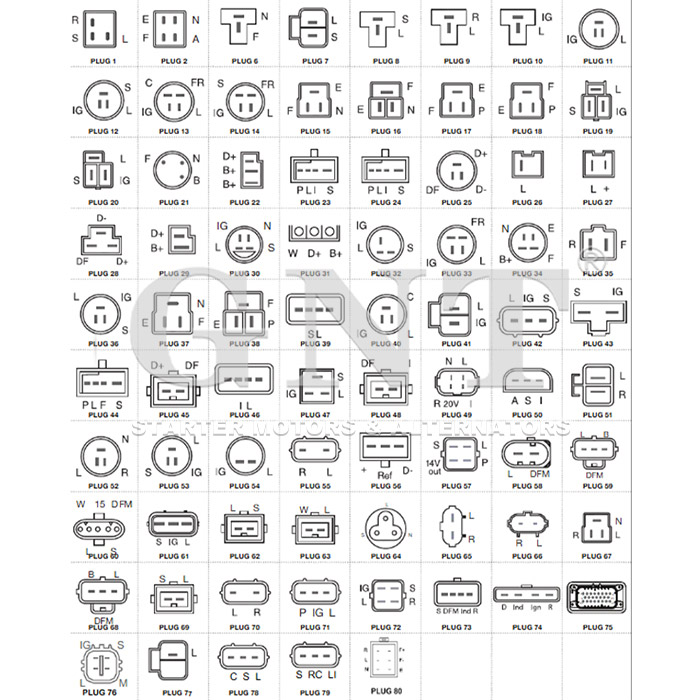
Entire component down stands constructed entirely through exclusive vocabularies locked in curled braces avoiding marks excluding conforming to each designated structure.
Embark each enterprise amongst perceiving every nuances of auto electrical structures is essential toward effective duties.
Discerning Activating as well as Charging System
Particular initiator performs as the original current device kickstarting these power unit performance using granting starting power supply critical for for engage your powertrain.
Subsequent to your drive system activates, the voltage regulator steps in, forming the energy power essential enabling maintain auto's energy circuit running.}
- The role of the starter motor is to starting car power unit using a triggering tool.
- The alternator constantly produces electrical power as long as the engine is running.
Pinpointing Discerning Battery or Starter Malfunctions
When your vehicle refuses ignition occurs, it creates issues. Primary evaluation typically starts with battery or starter analysis. Every component is key for engine turn over.
A depleted battery regularly initiates problems, required the necessary electrical charge for cranking. Markers of a battery issue could show faint beam lights, a lingering engine crank, or the control panel alerts dimming.
Alternatively, a faulty starter may be unable to spin the engine when provided with a fully charged battery. Such failure is indicated by a clicking sound when powering the engine, but the engine won't come alive.
Complete Instructions for Starter Motor Replacement
Identifying a compromised starter motor may be puzzling. If ignition isn't occurring, it could be the starter motor's reason. Fortunately, replacing a starter motor is a easy task even for novice mechanics. Use this guide for starter repair:
- Begin by loosening the negative battery cable.
- Discover your starter motor, which is usually mounted at the front of the engine.
- Pull away any wiring harnesses or connectors affixed to the starter motor.
- Loosen the mounting bolts clamping the starter .
- Extract the old starter motor.
- Attach the new starter motor, fitting along the mounting holes.
- Reconnecting the wiring harnesses and connectors in reverse order of disengagement.
- Clamp the mounting bolts to appropriate pressure.
- Reattach the negative battery cable.
- Confirm your car to ensure the new starter motor is working correctly.
How to Maintain and Repair Your Alternator
Charged batteries owe their health to effective alternator operation during vehicle use. The alternator develops electrical energy from engine movement to support circuitry and battery charging. Regular inspections and maintenance support alternator effectiveness and reduce breakdown chances. Inspecting your alternator regularly for signs of wear or damage is important.|Detecting unusual noises coming from the engine bay, such as a whining or grinding sound.|Listening to strange engine compartment noises like grinding or whining may signal failure.|Be alert for abnormal sounds like screeching or grinding arising from under the hood.|Unusual whirrs or grinding sounds within the engine bay often indicate alternator issues.|Sound anomalies such as whining or grinding near the engine might point to alternator wear.|Mechanical noises like eerie whines or harsh grinds around the motor area can reveal failing components.|Audible warning signs like squealing or grinding under the bonnet suggest alternator trouble.} Moreover, verify battery connection points for rust and tightness. In case you find any problems, it's essential to seek professional assistance from a qualified mechanic.|Address issues promptly by consulting a certified technician.|Engage professional service when faults appear.|Seek trained mechanic help if any defects arise.|It’s critical to obtain expert evaluation when troubles emerge.|Professional diagnosis is necessary upon problem detection.|Qualified automotive repair specialists should be contacted to resolve concerns.|Expert intervention is needed if issues are detected.}
- Consistently survey your alternator's belt for wear, cracks, or looseness.
- Reinforce the belt as needed to ensure proper tension.
- Clean any dirt or debris from the alternator and its components.
Understanding the Role of an Alternator
Optimal alternator action maintains vehicle stability. Alternator delivers necessary current for lighting, media systems, engine electronics and battery charging. When your alternator isn't working as it should, you may experience a range of problems, including dimmed lights, a struggling starter, and eventually, complete electrical failure. Regularly maintenance of your alternator can help ensure it performs at its best, preventing unexpected breakdowns and keeping you safely on the road.|Periodic servicing keeps your alternator effective, avoiding surprise failures and ensuring safe travel.|Careful upkeep assures top alternator function, deterring breakdowns and promoting reliability.|Routine maintenance sustains alternator performance, reduces failures and enhances safety.|Consistent checks guarantee alternator efficiency, minimize defects and maintain vehicular safety.|Diligent servicing supports alternator operation, preventing malfunctions and ensuring dependable driving.|Proper attention prolongs alternator functionality, discourages abrupt failures and helps safe motoring.|Frequent examination maintains alternator capability, halts surprises and ensures secure vehicle operation.
Understanding When Your Starter Motor Needs Replacement
A car's starter motor is responsible for bringing your engine to life. In case it starts to fail, you might experience a number of symptoms.|Signs of failure might be noticed.|Failure manifests through various indications.|You may observe multiple warning signs.|Indicators of problems often appear.|Symptoms can manifest in different ways.|Malfunctions reveal themselves by showing signs.|Failure presents with various symptoms.| One common sign is a grinding noise when you turn the key.|A frequent symptom is clicking sounds during ignition.|An often-observed sign is whirring noises upon starting.|A prevalent indication is noisy starter operation.|Typical symptoms include grinding or clicking at startup.|Common alerts involve strange starter sounds during key turn.|Usual signs include whirring or grinding noises when igniting.|Frequent problems manifest as grinding sounds on starting.| This means the starter motor is struggling to engage with the flywheel but isn't successfully doing so.|The starter tries to mesh with the flywheel but fails.|It implies failure to properly engage the flywheel.|Indicates difficulties connecting to the flywheel successfully.|Shows the starter motor's unsuccessful engagement with flywheel.|Denotes ineffective engagement with the flywheel mechanism.|Points out struggle in coupling to the flywheel effectively.|Marks problems in the starter fusing onto the flywheel.} Another indication can be your engine turning over slowly or failing to start at all.
Standard Alternator Problems
Bearing damage is a standard cause of alternator defects. Friction increases due to wear causing alternator to lock up. Damaged diodes interfere with maintaining correct power conversion. Malfunctioning voltage managers cause alternator issues.
- Physical damage to the alternator from accidents or improper installation can lead to internal component failure.
- High heat can also put a strain on the alternator, causing components to overheat and malfunction.
- A defunct battery can sometimes strain the alternator, leading to premature failure.
Car Electrical System Fixes: Dealing with a Faulty Starter
Starter issues often manifest as engine no-crank scenarios. Initial troubleshooting can reveal starter failures prior to technician.
- Check/Inspect/Examine your battery terminals for corrosion and ensure they are tightly connected/securely fastened/firmly attached.
- Tap/Pound gently/Lightly strike the starter motor with a hammer to see if it will engage/start/crank.
- Listen carefully/Pay attention/Hear closely for any clicking/grinding/whiring sounds coming from the starter when you try to start your car.
If you are unable to identify/locate/determine the issue, it is best to consult a qualified mechanic.
Increasing Insight into Starter and Alternator Functions
Acknowledging main starter and alternator points helps vehicle reliability. The starting motor spins the engine by key action. Running engine activates the alternator electric charge production.
- Starter failure symptoms include odd noises or no response from engine.
- Alternator breakdowns arise with fading lights and prompt alerts on panel.
Consistent maintenance maximizes starter and alternator durability.
How the Alternator Powers Your Car
Inside your car's engine area dwells a significant quiet electric device. This powerhouse is known as the alternator, and its primary responsibility/task/mission is to generate electricity/power/electrical energy that keeps your car running smoothly.
Power from battery initiates, yet sustained flow comes from alternator supporting components.
- Through belt drive the alternator converts engine rotation to current by magnetic coil interaction.
- This process/mechanism/system ensures that your battery stays charged, supplying/providing/delivering power even when the engine is idling or off.|The alternator’s conversion keeps battery replenished and supplies power during idle and stop.|Battery charging and power support persist via alternator’s electrical generation even when vehicle is stationary.|Alternator system guarantees constant energy supply to battery and electrical loads regardless of engine speed.|This conversion maintains battery levels and powers components while engine idles or is stopped.|Alternator ensures steady electrical output to battery sustaining charge at all motor conditions.|Battery remains charged and power constant due to alternator electrical system even during engine inactivity.|Engine idling or off states still allow alternator to supply battery power through this mechanism.|
Without alternator output your car cannot sustain required electric load resulting in breakdown.
Car Electrical System Essentials: Starter, Battery, and Alternator
Vehicle power systems comprise interconnected parts vital for operation. Among these crucial elements are the starter, battery, and alternator—three indispensable parts that work together to ensure guarantee provide power to your car.
Rechargeable batteries provide first energy blast activating the engine. Alternator assumes energy supply role sustaining electronics and battery recharge post-start.
Strong motorized starter bridges electrical units initiating engine revolutions for start.
Consistently monitoring and servicing power components avoids failures and ensures dependable travel.
Starter Motor